Rig tour: Stone Temple Pilots
We meet Dean and Robert DeLeo, alongside luthier/tech extraordinaire Bruce Nelson, to discover their tonal recipe

Introduction
"I've been using the same setup, the same rig since 1990,” Dean DeLeo, tells us, “every time we plug in it sounds great.” The guitarist’s soundcheck in London confirms this. It’s a huge, full- bodied sound, perfect for one of alternative rock’s most versatile players.
Favouring reliable rigs and reliable people, the Stone Temple Pilots team are a loyal bunch who Dean and bassist brother Robert are quick to praise, noting: “You’re only as good as the people around you”. FOH engineer James ‘Hootsie’ Huth has worked with them since the pre-Core days of ’90. Affable tech Bruce Nelson, who has manned his station side stage for over 16 years with STP and also builds the DeLeo brothers’ instruments (as well as guitars for the likes of Joe Perry).
“I don’t know where I’d be without him,” says Dean. “He’s just an amazing person.” So it’s only right we get his input alongside the sibling songwriting powerhouse duo with the instrumental chops to match.
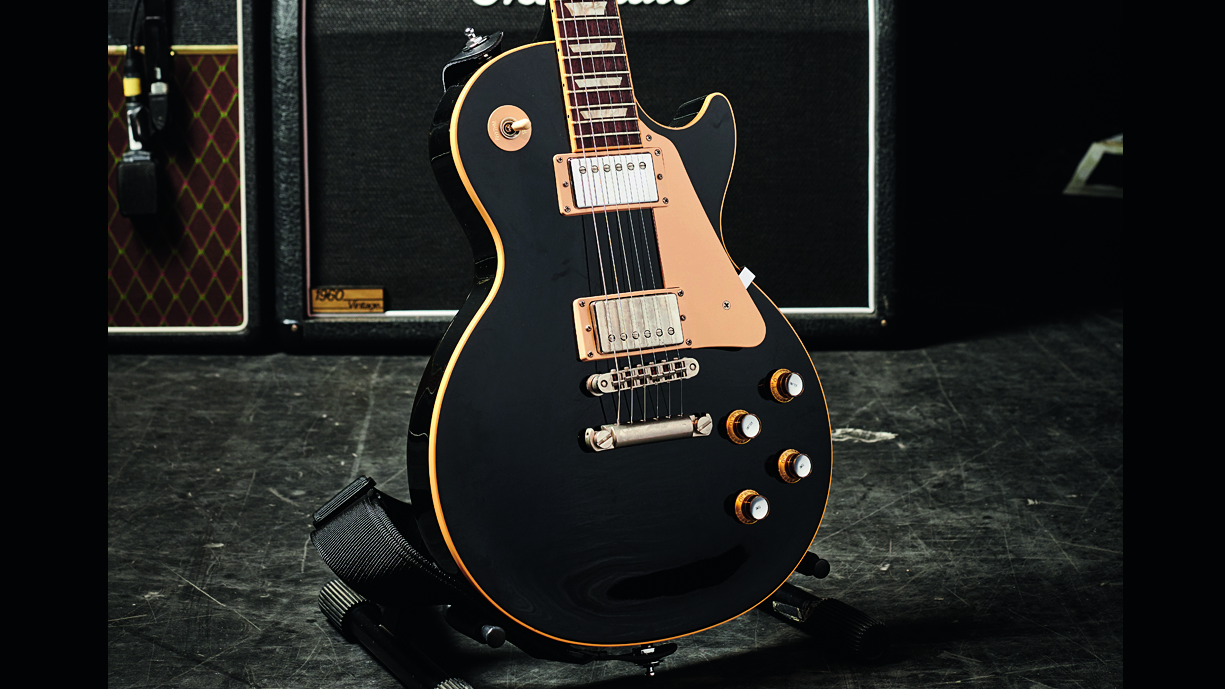
2009 Gibson Les Paul
Dean DeLeo
Bruce Nelson: All the Les Pauls in this rig are 2009. They all have Seymour Duncan Jazz pickups in the bridge; they’re clear and they’re pretty similar to the stock pickups the 70s Les Pauls have.
"With this rig I was trying to replicate his other 70s Les Pauls and that pickup was the closest. He’s playing on the bridge 99% of the time, the only time he’ll flip to the neck is when they’re jamming or something like that between songs. We’re mostly using gauge 10 strings, but on low alternate tunings we’ll go up to 11s.”
Dean DeLeo: “The guitars that I have with me now are my B rig stuff. All the A rig stuff are the solid bodies, these Les Pauls are semi hollow. Which are very different.
"They play a little different to begin with but they’re interesting because they’re semi hollow, they can get away from you. And fortunately usually when they get away from you they’re in key! [laughs] Which is always good. It’s nice to have that extra little thing to play with.”
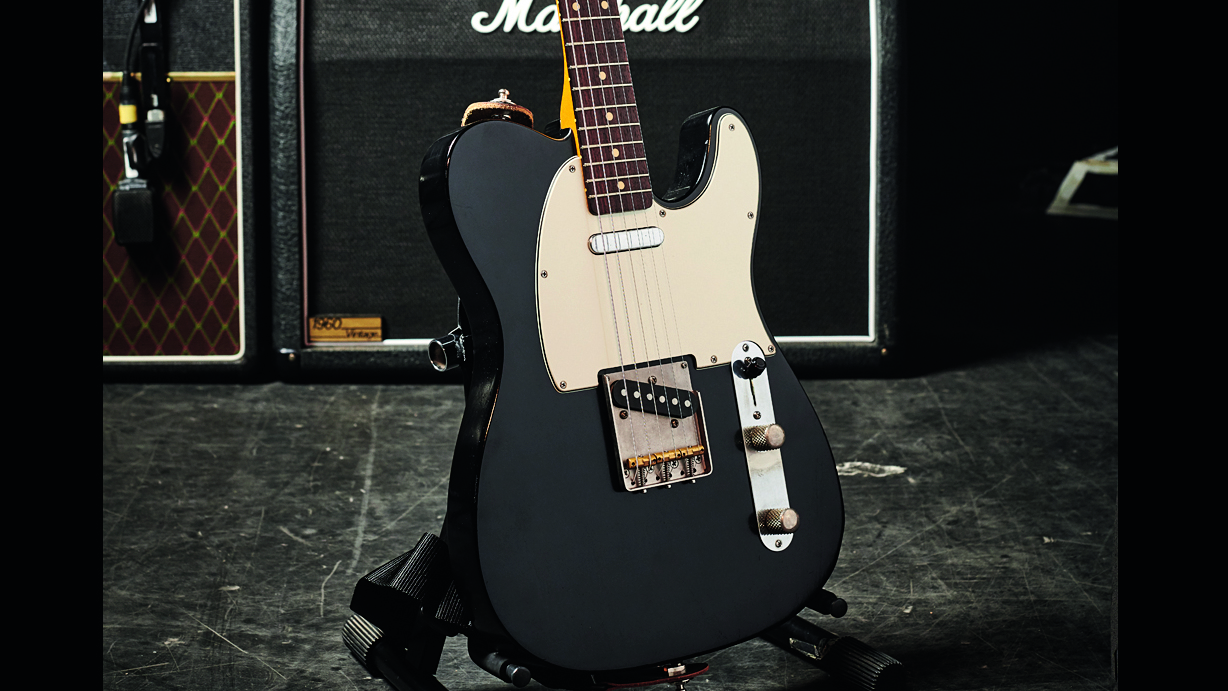
2009 Bruce Nelson T-style
Dean: "He is just an incredible luthier. He builds really, really fine instruments like the Tele- [style]. I have three [T-style guitars] he’s built me, and he’s built me a Strat-style. And what he’s just building for me now, it’ll be very close to the Gibson Les Paul Special with the P-90s. He’s just putting the finishing touches to that now.
“His guitars are great because in the studio, when you start layering guitars, and sometimes you can’t get them in tune – it’s really frustrating. But his... perfect! It’s such a peace of mind when you start layering guitars and they’re just perfectly in tune. It makes the recording process so much more delightful.”
Bruce builds really, really fine instruments
Dean DeLeo
Bruce: “This is the first guitar I built for Dean. It has Lindy Fralin pickups in it, although I’ve now switched to using Lollars [for builds]. It’s swamp ash so it’s fairly light, and the neck is chunky but comfortable. Kind of a soft V-shape.
"The [bridge] is Callaham and it’s made of steel so it resonates. It’s currently tuned to D minor for Lounge Fly. The serial number on this is his birthday and on every subsequent guitar I’ve made for him has been a birthday; of his kids or wife.”
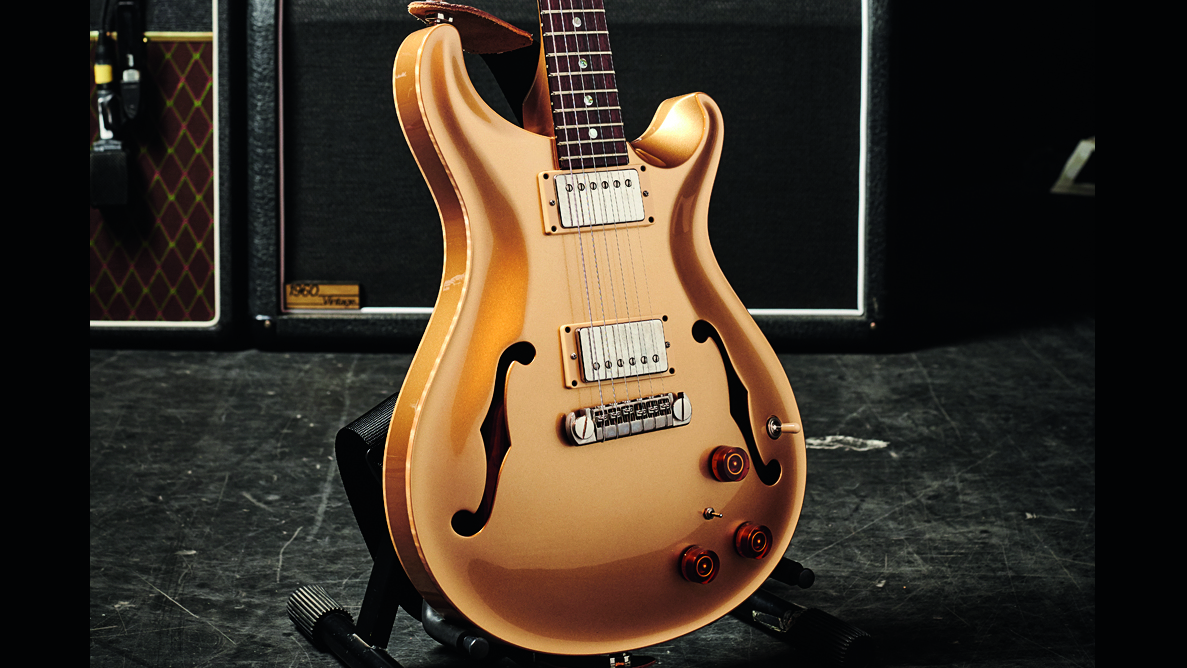
PRS McCarty II
Bruce: “It’s semi-hollow. The piezo has its own designated output to a DI box and then the electric pickup signal goes to the amp like normal.”
Dean: “I use that generally for Creep and Sour Girl. It allows me to do a nice blend between the electric and the acoustic sound. Those guys make beautiful instruments too.”
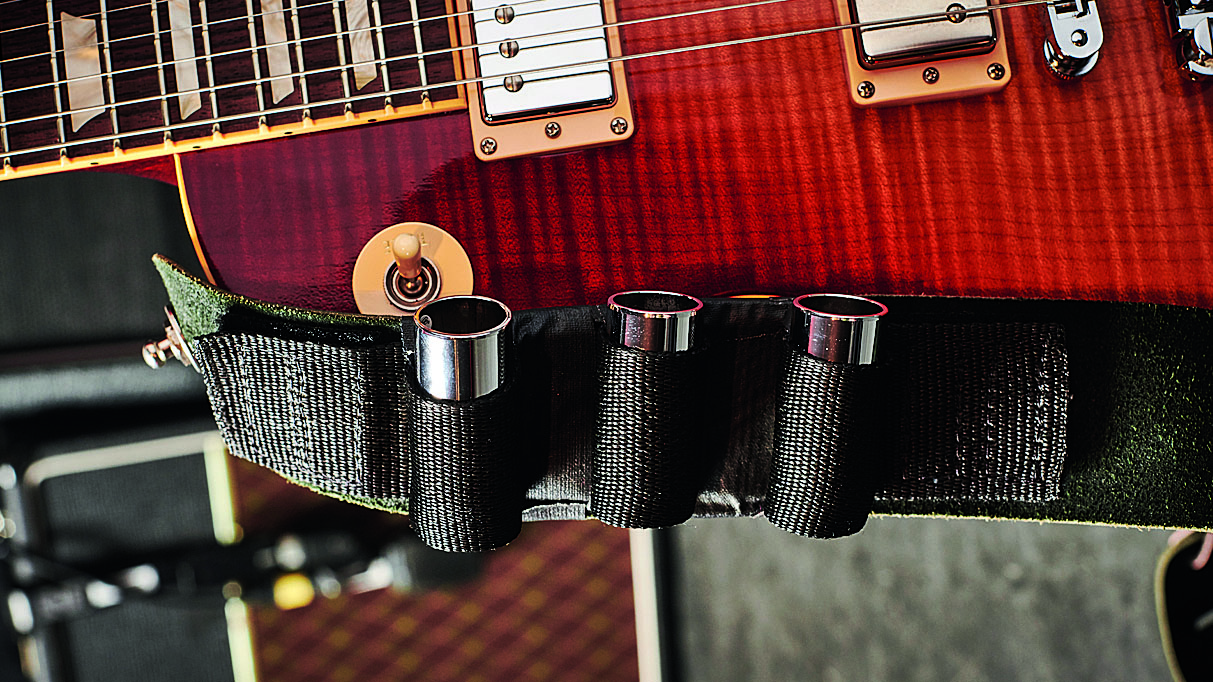
Slide bandolier
Dean: “I’ve got to grab a slide for each section of Big Empty [there’s three slide sections in the song between the chorus rhythm parts]. I thought how am I going to pull this off? Let’s build a thing here and give me something like a bullet strap.
"And it’s kind of cool because if I have someone’s attention while I’m finishing up the slide part, I toss [a slide] into the audience. It’s nice.”
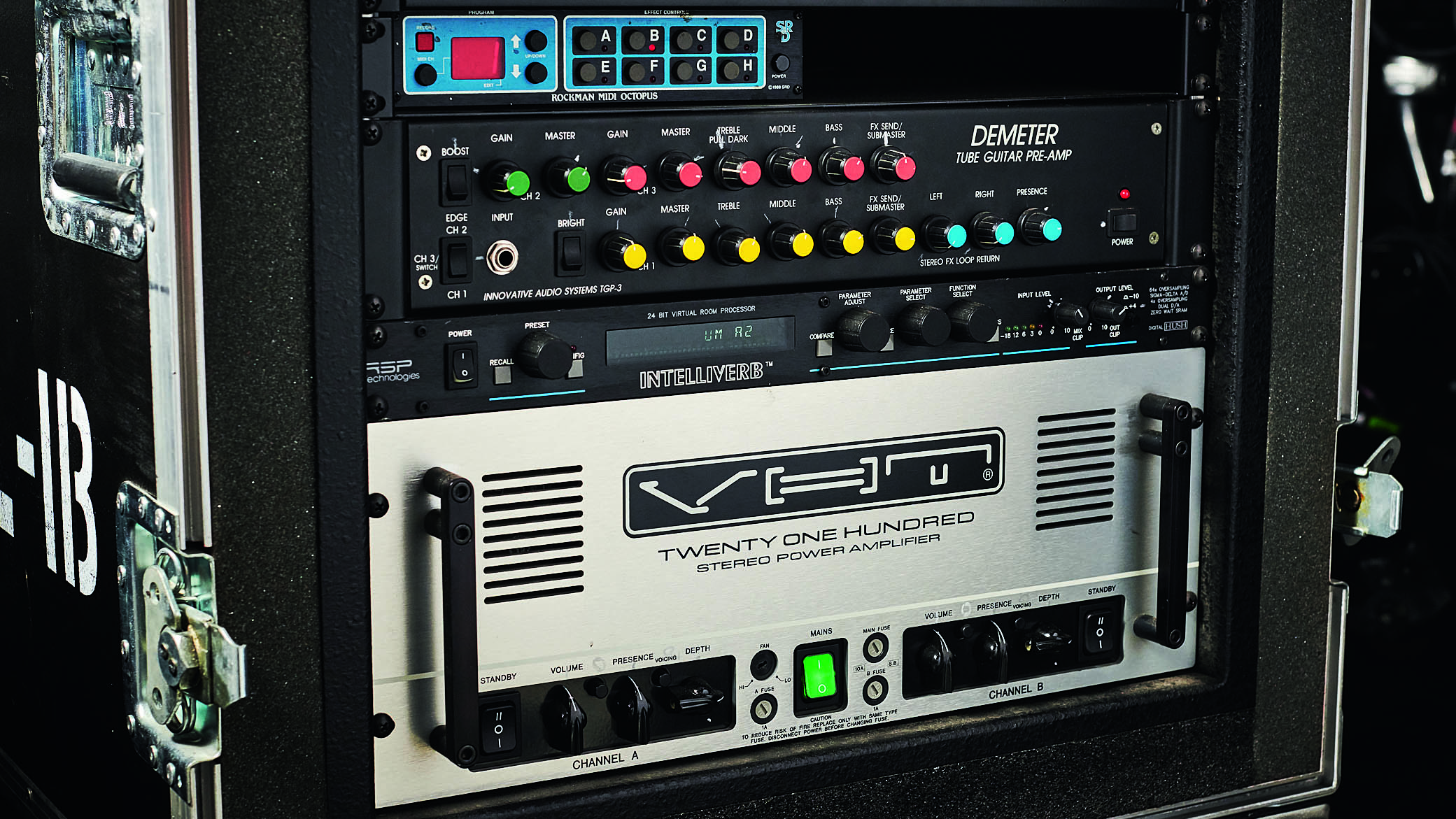
Demeter TGP-3 preamp, VHT 2100 Classic power amp and Rockman MIDI Octopus
Dean: "When we put that VHT and that Demeter together it really allowed me to take up a lot of room for a three-piece. We really spent a lot of time figuring out what would be best for us and it’s nice because with the VHT we run stereo, that’s why you see the two 4x12s. The VHT goes through the Demeter, runs through the two 4x12s and then I have the AC30 in the middle.
“So the VHT runs stereo and then it goes into the Demeter, which is a three-channel amp. With the first channel you can get a really nice blues tone, but I don’t use the first channel at all. I use channels two and three.
"Channel two just gives me a little more gain and I get my mellow, less saturated tones backing off the volume of the guitar. And it really holds a nice clarity and body to it, I just back it off.”
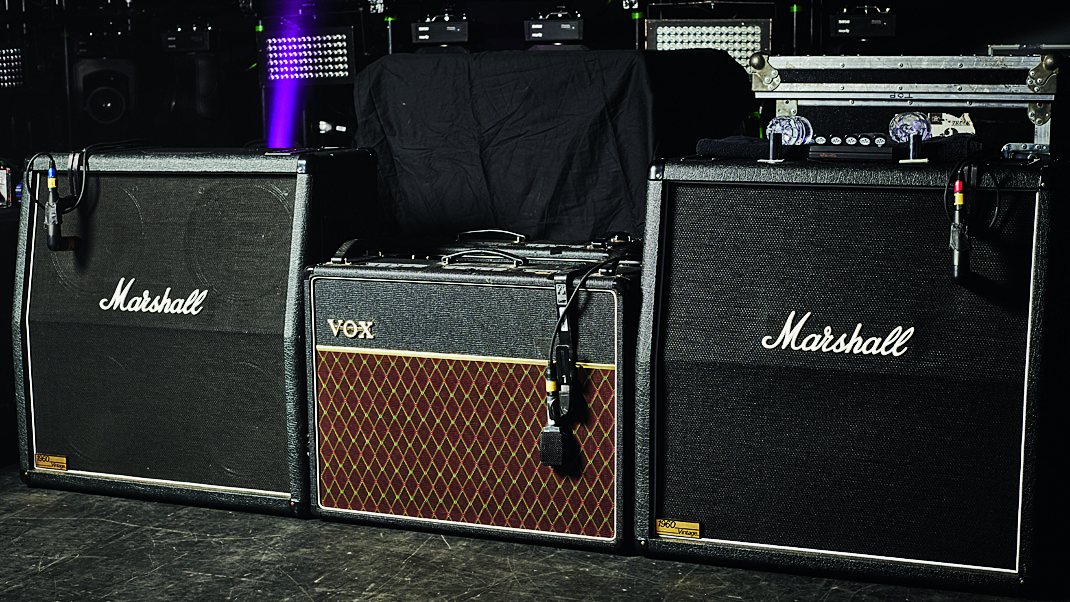
Vox AC30
Dean: “If you hear the AC30 it is set really clean, real chimey and gets that nice chimey mid stuff and then the [VHT / Demeter] has got the big bottom and the nice sizzly top. That AC30 is really there to capture that clarity of the chords. You’d be astounded when you turn that AC30 off – it’s obvious right away something is really missing.
“It’s important for me that I hear every string of the chord. There’s a lot of interesting chords being played throughout the night – I wish I could tell you what they were [laughs] but I don’t know! I just know what I want to hear and I get it. But that AC30 set real clean...one of the greatest amps, man.
It’s important for me that I hear every string of the chord
Dean DeLeo
"It’s funny, we were doing the last record and we had a ton of amps just stacked up and Robert and I looked at it, and we’re like, ‘They’re all English!’ We had a Laney, a bunch of Supros, Selmer, some Voxs, some really nice little Marshall 18-watt combos. They only did those for two years and I have a few of those. Boy, that’s a great amp. It was all from the English invasion.”
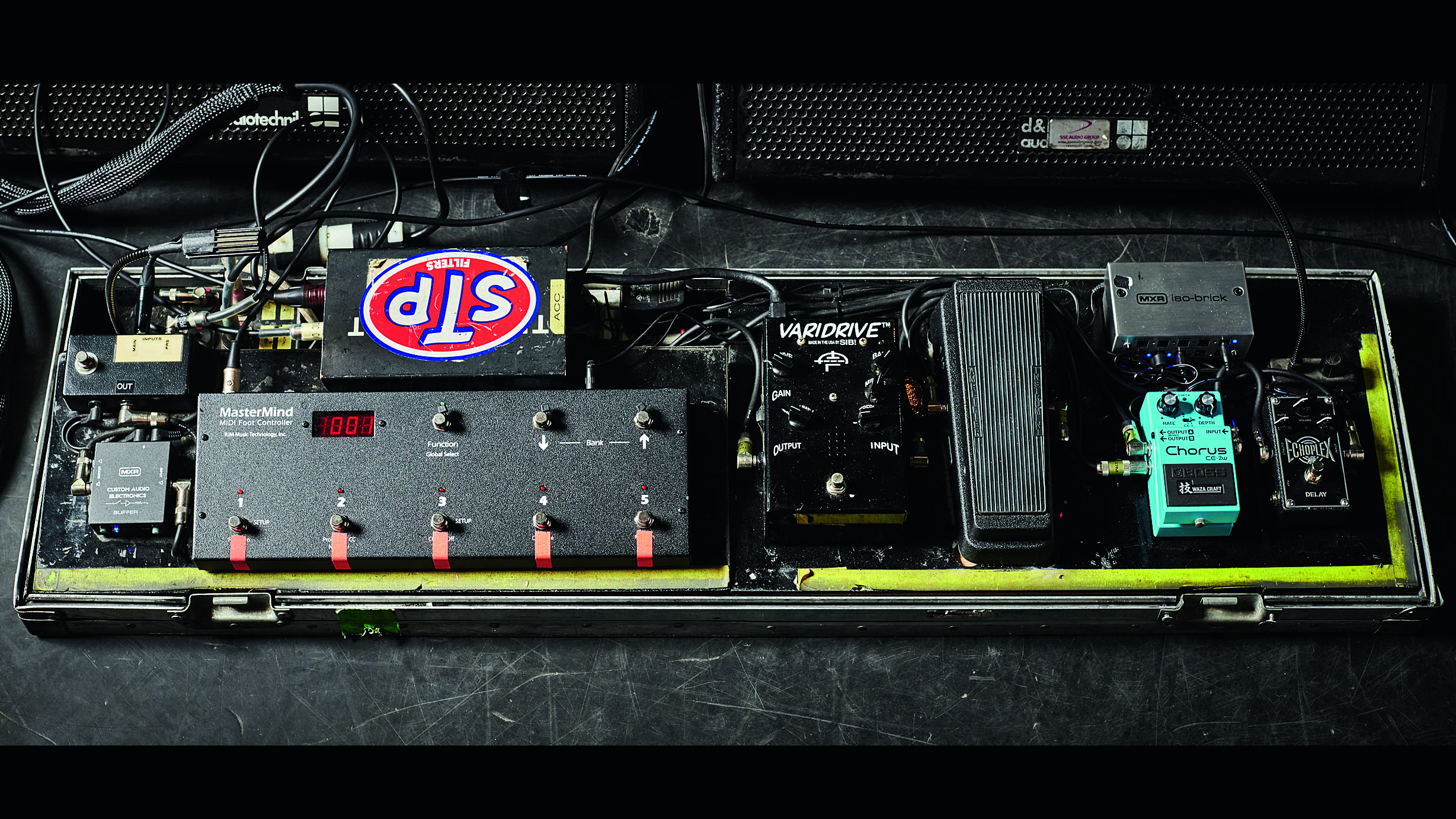
Pedalboard
Mastermind MIDI foot controller
Dean: “I have a five-bay patch that I go from throughout the night; 1 and 2 are my kind of clean. Patch 3 is a wetter tone. So 1 and 2 are the same, 3 and 4 are the same but 2 and 4 are just louder. If I want to get into a solo. I hit the 4 patch for the chorus on Dead And Bloated for just a big [makes distorted noise] just to move everyone’s hats out there!
"Then the 5 patch is a big wet solo patch I use a couple of times throughout the night but generally I solo on the 4 patch.”
Boss CE-2W
Dean: “I drastically went through my effects when we were playing with Chester [Bennington]. I felt there was too much chorus. I want to dial that down and hear more of the guitar, not so much of the effects. But it definitely comes in handy.
"The way I had it set is I wanted it to appear as if another guitar was coming in. An example is Trippin’ On A Hole In A Paper Heart. I’ll play that clean and then when I come to the chorus it just sounds like a whole other guitar is coming in. It was just more of a differentiation, to give the illusion another guitar is coming in. And I know Hootsie, he does some stuff out front too.”
I’m not using it for a chorus, I’m trying to emulate a Leslie
Dean DeLeo
“I was using a CE-1, that old Roland thing, forever and ever. They were original from back in the day but there was just too much stuff to break getting moved around.
"I finally succumbed to [another] pedal. But I’m not using it for a chorus, I’m trying to emulate a Leslie. I’ve got it really cranked up and it’s the pedal that I found that wouldn’t give me that detuned chorusy thing, I just wanted that fast Leslie sound.”
Dunlop Echoplex delay
Dean: "This is a cool slapback, I have it set on a nice tight delay. It’s kind of cool to solo with at times when you’re playing those country licks. We were doing [Middle Of Nowhere], the first song on the record with Jeff [Gutt, vocals] and that pedal came in handy for that.”
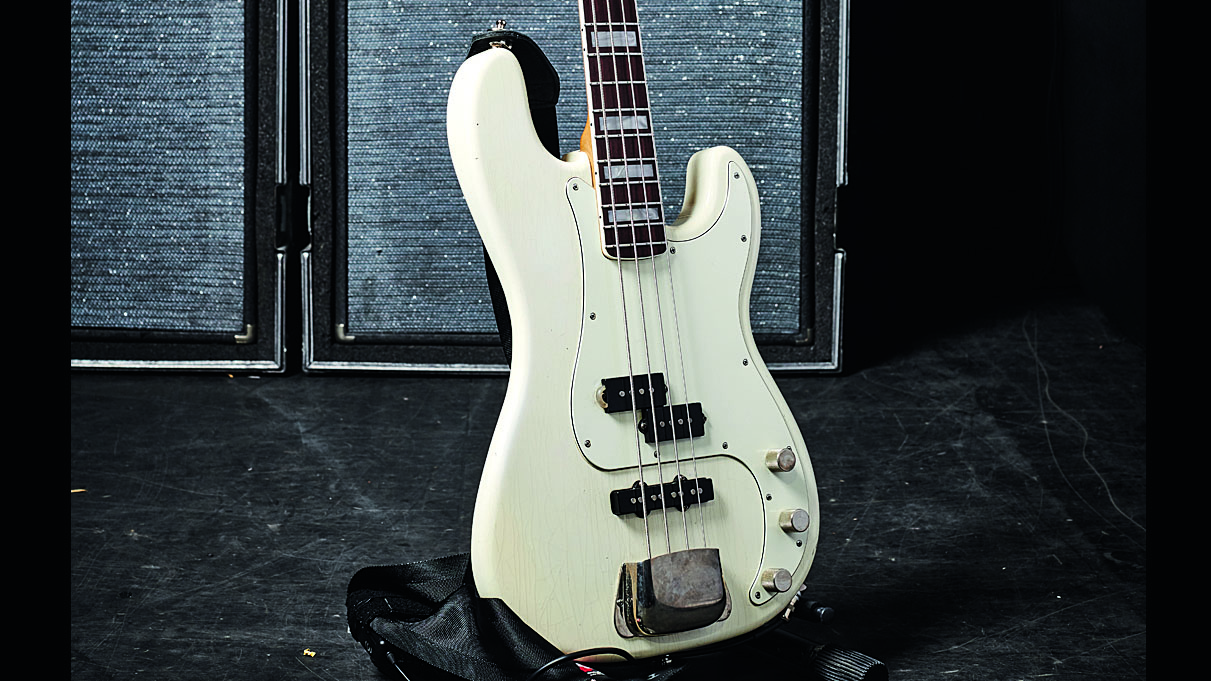
Bruce Nelson PJ-style bass
Robert DeLeo
Robert DeLeo: “My experience with the vintage instruments I have at home definitely influenced what I wanted. I’ve always liked the block inlay bound neck that came in ‘66 and I always loved Olympic White.
"I enjoyed seeing Brian Wilson play bass, playing with his thumb. And the painted headstock – the custom ones they made back then. It’s a Jazz neck, between a P and a J, Lollar PJ pickups and brass saddles, brass nut. I notice more sustain with brass. I’ve got a detuner which is very convenient too.
“Bruce made two of these basses and I named them after my two sons
Robert DeLeo
“Bruce made two of these basses and I named them after my two sons. The serial numbers are their birthdays. The one named after my other son recently got stolen and then it got recovered at a pawn shop. This is the Duke bass and my other son is Malcolm so that’s the Malcolm bass.”
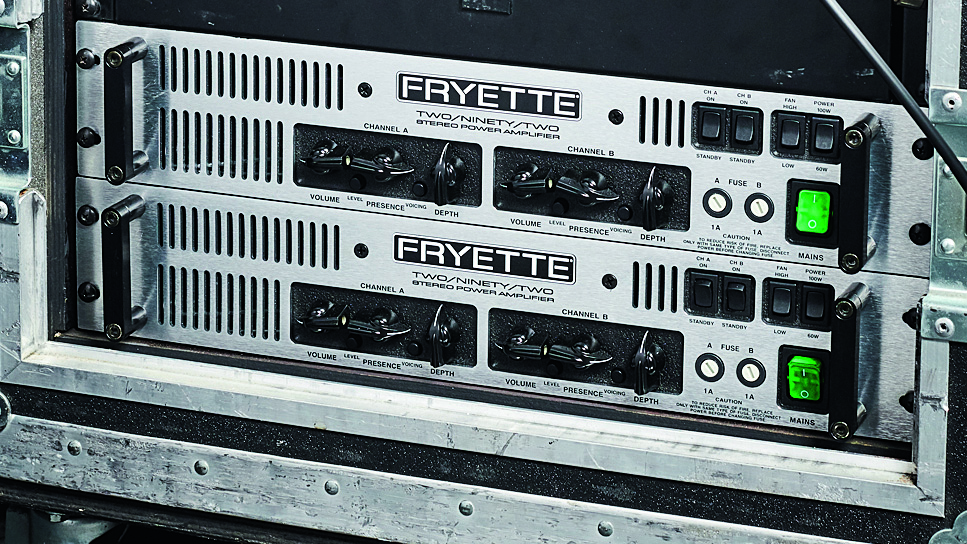
Fryette 292 stereo power amps
Robert DeLeo: “I just got these amps and they’re made by Stevie Fryette who does VHT and I’m really happy with them. They’re stereo, two space, 100-watts per side. Four KT88s – two per side. I’d been looking around for a while for something that would do what I wanted it to do, and now I’ve got just the right thing.
"I was using a solid state amp with [my Bass POD, see next] but I wanted to get more fidelity and I noticed when I switched over to [the Fryette], it bloomed. It really made a huge difference."
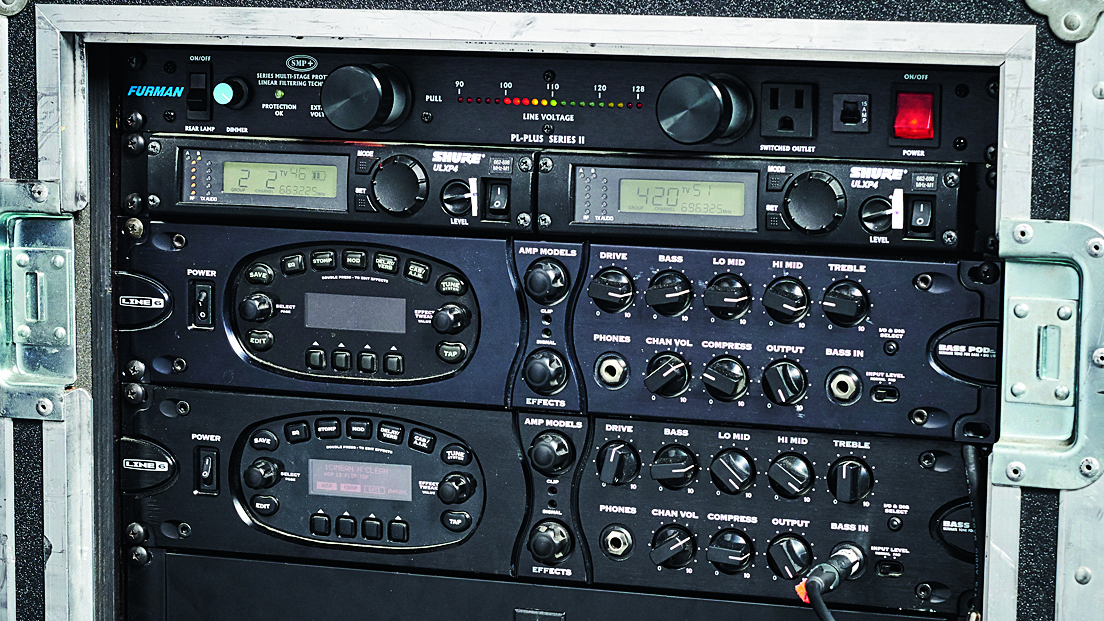
Line 6 Bass POD XT Pro
Robert: “I’ve been using this Bass POD since 2008... actually I first got it in Army Of Anyone in 2006/2007. I kind of model around what I do in the studio, it gives me a little flexibility to get into the sound that I use in the studio. I have a 1970 Marshall 8x10 and I use that with the Ampeg V4 head and then I split that off into a [Ampeg] ‘67 B15 FlipTop. It covers a lot of ground.
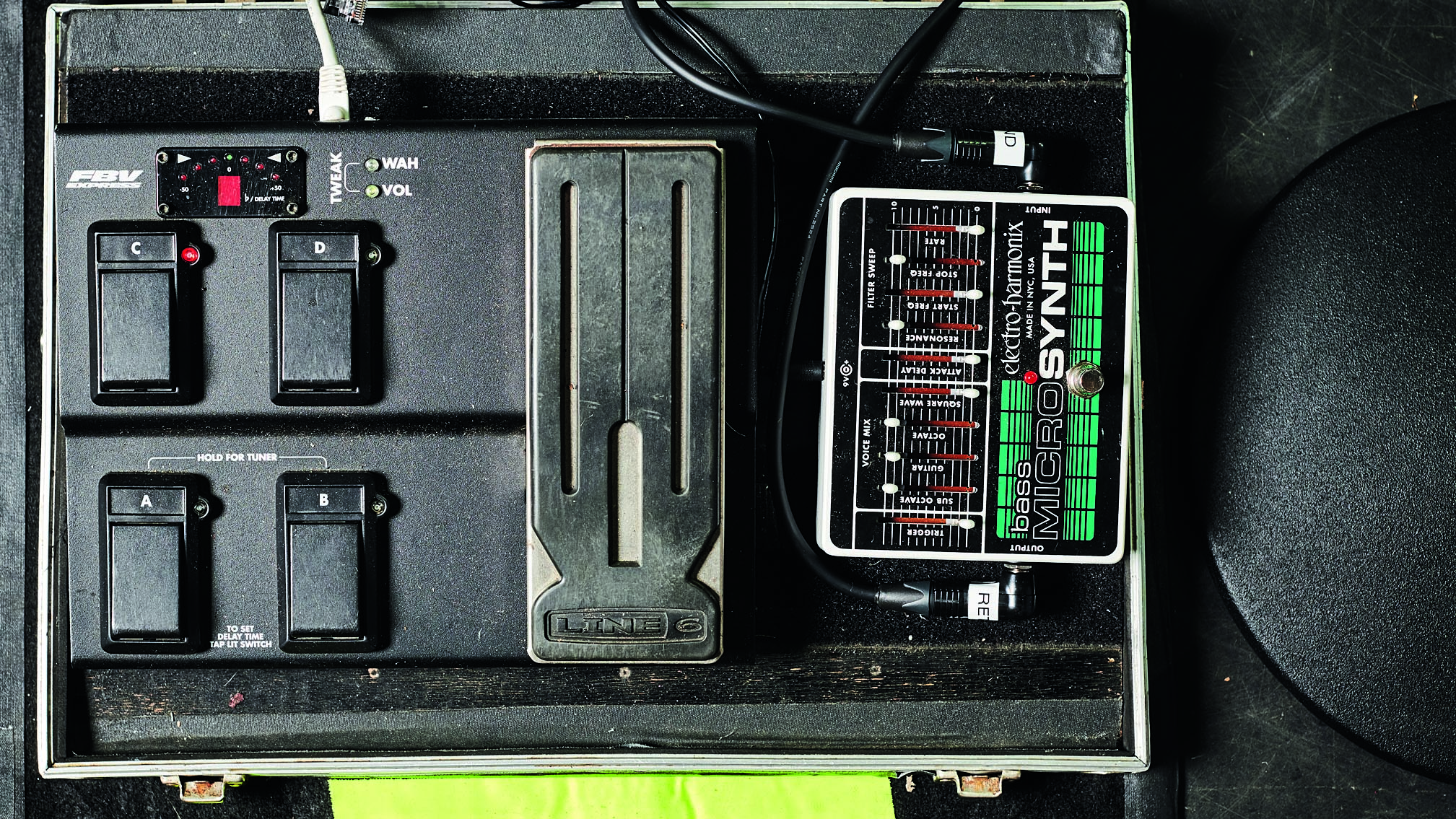
Line 6 FBV Express footswitch and Electro-Harmonix Bass Micro Synth
Robert: “I’ve used that on records we’ve done before and for the set we play at the moment I use it on the solo section of the song Meadow, which is from the last record. I love that pedal.”
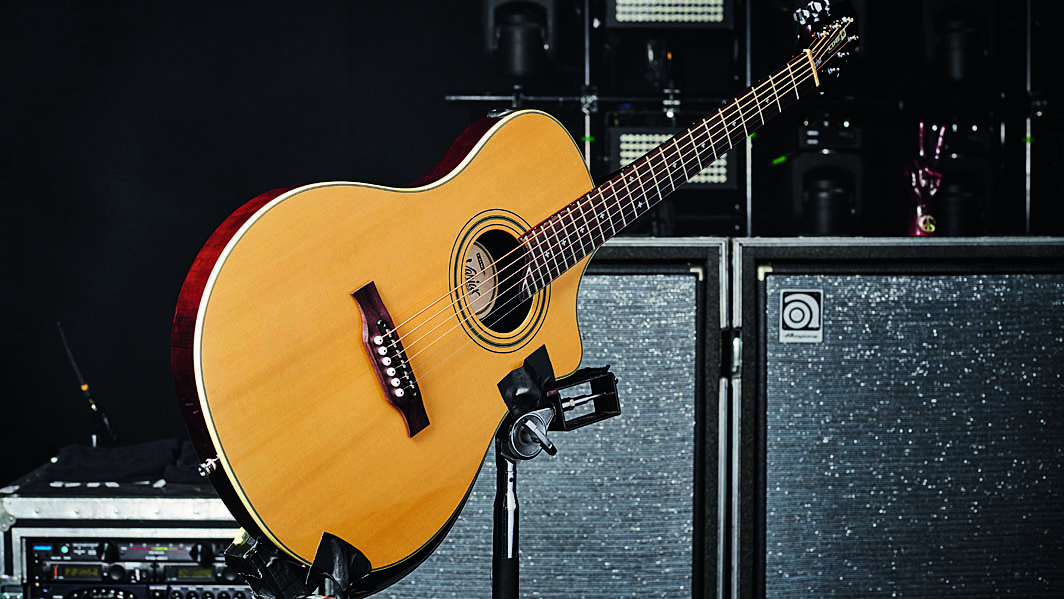
Line 6 Variax acoustic
Robert: “We use this in Lounge Fly and have it on the 12-string setting. It’s nice and convenient. I used to use a real acoustic but sometimes you get up there and all of a sudden [makes feedback noise]. It works for that section. Hopefully I can put it on the nylon setting and play some bossa nova!”

Rob is the Reviews Editor for GuitarWorld.com and MusicRadar guitars, so spends most of his waking hours (and beyond) thinking about and trying the latest gear while making sure our reviews team is giving you thorough and honest tests of it. He's worked for guitar mags and sites as a writer and editor for nearly 20 years but still winces at the thought of restringing anything with a Floyd Rose.
“Its mission is simple: unleash the power of any amplifier or line-level source without compromise”: Two Notes promises a “watershed” in tube amp control with the Torpedo Reload II
“A pedal that sings with harmonic richness and blooming touch response”: Tone King offers up boutique tube amp tones for your pedalboard with the Imperial Preamp
“Its mission is simple: unleash the power of any amplifier or line-level source without compromise”: Two Notes promises a “watershed” in tube amp control with the Torpedo Reload II
“A pedal that sings with harmonic richness and blooming touch response”: Tone King offers up boutique tube amp tones for your pedalboard with the Imperial Preamp











